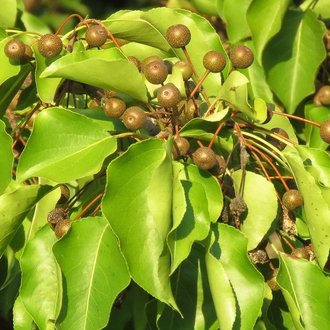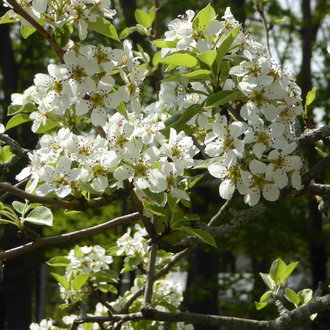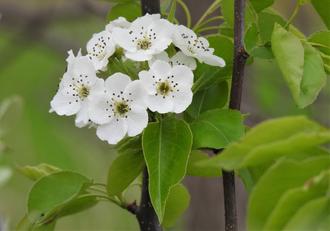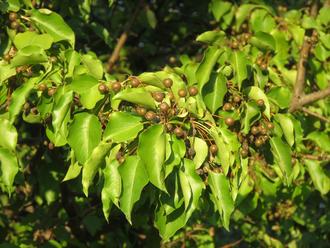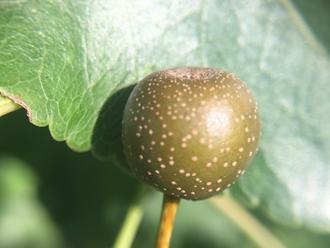Callery Pear (Pyrus calleryana Decne.)
Also known as Bradford pear.
↑Summary
Widely planted as a street tree in the U.S., this species is native to East Asia and has become invasive across a large range of North America.
↑Similar Plants
↑Control
This species spreads readily by birds consuming the fruit, and landscaping plants tend to be vigorous and have high seed production, because they have less competition from other plants and often are planted in ideal conditions for it, so the most important aspect of control is removing it from landscaping. Without removing source trees, control attempts are going to be short-lived and require continual follow-up.
When source populations are removed, this species is usually relatively easy to remove from a site. Seedlings and smaller saplings can be uprooted. Larger trees that are surrounded by competing vegetation can be cut repeatedly. This species has the ability to resprout, but on sites with heavy competition, cutting once or twice can be sufficient to kill a tree. In some cases, cutting trees once or twice can release other woody vegetation, which will then overtop this tree and shade it out.
For trees with less competition, a strategy to remove them in one season is to cut them about 6 feet above the ground; the plant will then concentrate energy in the area just below the cut, preparing to resprout. When the plant resprouts, you can then cut another 2 feet below that, and repeat. This can kill the trees by depleting their energy stores.
Many sources recommend herbicides to control this species. However, most herbicides used on this species will kill most other species as well. As such they are only suitable when this plant is not growing with any competing native species, such as when it is growing in a monoculture or is only growing with other invasive plants. Without addressing source populations and adding in competing vegetation, this species will just recolonize areas where it is removed.
Ensuring that there is an adequate source of native species occupying a similar niche (early-successional vegetation preferring high light conditions) can help protect against Callery pear invasion. One of the species that directly competes with this one and occupies one of the most similar niches is black cherry (Prunus serotina), which occurs everywhere Callery Pear does in North America, excepting California and Utah.
↑Uses
Until recently this tree was widely planted in landscaping, especially as a street tree. The 'Bradford' Cultivar is one of the most widely planted cultivars, and it is often referred to as the "Bradford Pear".
Its use in landscaping has declined because of its invasive potential, propensity to drop limbs on cars or sidewalks, and its foul-smelling blossoms.
↑Links & External Resources
• Pyrus calleryana (Callery Pear) | Illinois Wildflowers (About This Site)
• Pyrus calleryana (Callery Pear) | USDA PLANTS Database (About This Site)
• Pyrus calleryana | Go Botany (About This Site)
• Callery Pear | Virginia Tech Dendrology Factsheets (About This Site)
• Pyrus calleryana | Biota of North America Project (BONAP) (About This Site)
• Pyrus calleryana | NatureServe Explorer (About This Site)
• Pyrus calleryana | Flora of North America (About This Site)
• Pyrus calleryana | Missouri Plants (About This Site)
• Bradford Pear | Maryland Biodiversity Project (About This Site)
• Pyrus calleryana Decne. | Plants of the World Online (POWO) (About This Site)
• Pyrus calleryana Dcne. (Callery Pear) | Digital Atlas of the Virginia Flora (About This Site)



